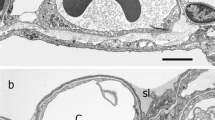Summary
Isolated cells obtained from foetal rat bone (calvarium) by collagenase digestion can be separated into three subpopulations on the basis of surface charge by free flow electrophoresis. These subpopulations have been tentatively identified by numerical, biochemical and functional criteria and are believed to be composed of: (1) bone resorbing cell types, designated Peak I cells; (2) fibroblasts and loose connective tissue cells, designated Peak II cells; and (3) a mixture of osteoblasts and osteoprogenitor cell types, designated Peak III cells. the anatomical position of these subpopulations in the whole calvarium was determined by comparing the results of histochemical and morphological experiments with the results of biochemical experiments. It was found that Peak I cells are located predominantly on the ventral (endocranial) surface, Peak II cells in the connective tissue periosteal membranes and Peak III cells on the dorsal (ectocranial) surface and in the suture line areas. The response of these cell types to parathyroid hormone and calcitonin with regard to cAMP production and45Ca release from devitalized bone is examined and indicates that cells from Peak I and Peak III both respond to parathyroid hormone but only the cells from Peak I respond to calcitonin.
Similar content being viewed by others
References
Altman, A. J., Bandelin, J. G., Dominguez, J. H. &Mundy, G. R. (1978) Differentiation of isolated calvarial cells into a mature heterogenous bone cell population in culture.Met. Bone Dis. Rel. Res. 1, 75–9.
Bessey, O., Lowry, O. &Brock, M. (1946) A method for the rapid determination of alkaline phosphatase.J. biol. Chem. 164, 321–9.
Boyle, W. (1968) An extension of the51Cr-release assay for the estimation of mouse cytotoxins.Transplantation 6, 761–4.
Burks, J. &Peck, W. A. (1978) Bone cells: a serum-free medium supports proliferation in primary culture.Science 199, 542–4.
Chen, T. L. & Feldman, D. (1980) 1,25(OH)2D3 receptor concentration in primary bone cell cultures is altered by the rate of cell division.Am. Soc. Bone Min. Res. 34A (abstract).
Deshmukh, K. &Kline, W. G. (1976) Characterization of collagen and its precursors synthesized by rabbit articular cartilage cells in various culture systems.Eur. J. Biochem. 69, 117–23.
Dziak, R. &Brand, J. S. (1974) Calcium transport in isolated bone cells: bone cell isolation procedures.J. Cell Physiol. 84, 75–84.
Fishman, D. A. &Hay, E. D. (1962) Origin of osteoclasts from mononuclear leucocytes in regenerating newt limbs.Anat. Rec. 143, 329–37.
Goldner, J. (1938) A modification of the Masson trichrome technique for routine laboratory purposes.Am. J. Pathol. 14, 237–42.
Ham, A. W. (1974)Histology. 7th edn. Philadelphia: Lippincott.
Hannig, K. (1972) Separation of cells and particles by continuous free flow electrophoresis. InTechniques of Biochemical and Biophysical Morphology (edited byGlick, D. andRosenbaum, R. M.), pp. 423–440. New York: Wiley.
Hawker, C. D., Glass, J. D. &Rasmussen, H. (1966) Further studies on the isolation and characterization of parathyroid polypeptides.Biochemistry 5, 344–51.
Jee, W. S. S. &Nolan, P. D. (1963) Origin of osteoclasts from the fusion of phagocytes.Nature, Lond. 200, 225–6.
Kono, T. (1968) Purification and partial characterization of collagenolytic enzymes fromClostridium histolyticum.Biochemistry 7, 1106–14.
Luben, R. A., Wong, G. L. &Cohn, D. V. (1976) Biochemical characterization with parathormone and calcitonin of isolated bone cells: Provisional identification of osteoclasts and osteoblasts.Endocrinology 99, 526–34.
Mundy, G., Altman, A., Gondek, M. &Bandelin, J. (1977) Direct resorption of bone by human monocytes.Science 196, 1109–12.
Peck, W. A., Birge, S. &Brandt, J. (1967) Collagen synthesis by isolated bone cells: Stimulation of ascorbic acidin vitro.Biochem. biophys. Acta 142, 512–25.
Peck, W. A., Birge, S. A. &Fedak, S. A. (1964) Bone cells: Biochemical and biological studies after enzymatic isolation.Science 146, 1476–7.
Puzas, J. E. &Brand, J. S. (1979) Parathyroid hormone stimulation of collagenase secretion by isolated bone cells.Endocrinology 104, 559–62.
Puzas, J. E. &Goodman, D. B. P. (1978) A rapid assay for cellular deoxyribonucleic acid.Analyt. Biochem. 86, 50–5.
Puzas, J. E., Vignery, A. &Rasmussen, H. (1979) Isolation of specific bone cell types by free flow electrophoresis.Calcif. Tiss. Intl. 27, 263–8.
Randerath, K. (1966)Thin Layer Chromatography. 2nd edn. p. 110. New York: Academic Press.
Rasmussen, H. &Bordier, P. (1974)The Physiological and Cellular Basis of Metabolic Bone Disease. Baltimore: Williams and Wilkins.
Thompson, E. R., Baylink, D. J. &Wergedal, J. E. (1975) Increases in number and size of osteoclasts in response to calcium or phosphorus deficiency in the rat.Endocrinology 97, 283–94.
Wong, G. L. &Cohn, D. V. (1975) Target cells in bone for parathormone and calcitonin are different: Enrichment of each type by sequential digestion of mouse calvaria and selective adhesion to a polymeric surface.Proc. natn. Acad. Sci., U.S.A. 72, 3167–71.
Author information
Authors and Affiliations
Rights and permissions
About this article
Cite this article
Puzas, J.E., Jensen, J.A. Electrophoretically separated bone cell types from the foetal rat calvarium: A histochemical and biochemical study. Histochem J 14, 561–571 (1982). https://doi.org/10.1007/BF01011889
Received:
Revised:
Issue Date:
DOI: https://doi.org/10.1007/BF01011889




